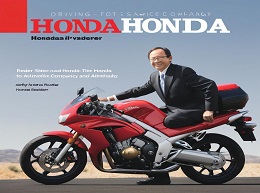Driving Honda: Inside the World’s Most Innovative Car Company

Driving Honda: Inside the World’s Most Innovative Car Company - A Comprehensive Review
"Driving Honda: Inside the World’s Most Innovative Car Company" by Jeffrey Rothfeder provides a fascinating exploration into the inner workings of Honda, a company renowned for its innovation and efficiency. Rothfeder delves into the principles, practices, and culture that have propelled Honda to the forefront of the automotive industry. This review will unpack the key insights from the book, highlight standout examples, and discuss how Honda’s approach can inspire other organizations.
The Essence of Honda's Innovation
Honda is not just a car company; it’s a symbol of relentless innovation and engineering excellence. Rothfeder’s book reveals the DNA of Honda, focusing on its unique methodologies, employee culture, and the strategic decisions that distinguish it from competitors.
The Honda Way: Foundational Principles
At the heart of Honda’s success are its core principles, often referred to as "The Honda Way." These principles guide everything from day-to-day operations to long-term strategic planning.
Respect for the Individual
One of the cornerstones of Honda's philosophy is respect for the individual. This principle fosters a culture where every employee’s opinion is valued, encouraging innovation at all levels of the organization.
Example: Employee-Driven Innovation
A classic example of this principle in action is Honda's suggestion system, where employees are encouraged to submit ideas for improvement. This system has led to numerous innovations, such as improvements in manufacturing processes and product features. For instance, the idea for a more efficient assembly line configuration at the Marysville, Ohio plant came from a floor worker, not an executive.
The Pursuit of Excellence
Honda’s commitment to excellence is evident in its meticulous approach to engineering and design. This pursuit ensures that every product meets the highest standards of quality and performance.
Example: The Honda Civic
The Honda Civic is a testament to this pursuit. Through continuous improvements based on customer feedback and rigorous testing, the Civic has evolved into one of the most reliable and popular compact cars globally. Each generation of the Civic incorporates cutting-edge technology and innovative features, maintaining its reputation for excellence.
Engineering Without Borders: Honda’s Global Perspective
Honda’s global strategy is another key aspect of its success. Unlike many companies that centralize operations, Honda adopts a decentralized approach, with significant autonomy granted to regional subsidiaries.
Localized Production
Honda’s strategy of localized production enables it to cater to specific market needs effectively. By building cars in the markets where they are sold, Honda can respond quickly to local demands and preferences.
Example: The Honda Accord in America
The Honda Accord, produced in the United States, exemplifies this strategy. Tailored to meet the preferences of American consumers, the Accord has consistently ranked as one of the best-selling cars in the U.S. This success is attributed to Honda’s ability to understand and respond to local market trends and consumer preferences.
Innovation in Manufacturing: The Power of Flexibility
Honda’s manufacturing processes are designed to be flexible, allowing the company to adapt quickly to changes in demand and incorporate new technologies.
The Flexible Manufacturing System (FMS)
The Flexible Manufacturing System is a hallmark of Honda’s production strategy. It enables different models to be produced on the same assembly line with minimal downtime for reconfiguration.
Example: The Swindon Plant
At Honda’s Swindon plant in the UK, the FMS allows the production of various models, including the Civic and the CR-V, on a single line. This flexibility not only improves efficiency but also reduces costs and increases the company’s ability to respond to market fluctuations.
Commitment to Sustainability: Beyond Green Vehicles
Honda’s innovation is not limited to automotive technology; it extends to environmental sustainability. The company is committed to reducing its environmental footprint through various initiatives.
The Green Factory
Honda’s concept of a “green factory” focuses on minimizing waste and reducing emissions throughout the manufacturing process.
Example: Yorii Plant
The Yorii plant in Japan is one of the most advanced and eco-friendly car manufacturing facilities in the world. It features state-of-the-art technology to reduce CO2 emissions and improve energy efficiency, setting a benchmark for sustainable manufacturing practices.
Hybrid and Electric Vehicles
Honda has been a pioneer in the development of hybrid and electric vehicles, reflecting its commitment to sustainable transportation.
Example: Honda Insight
The Honda Insight, introduced in 1999, was one of the first hybrid vehicles available to consumers. This early adoption of hybrid technology positioned Honda as a leader in the push towards greener transportation solutions. More recently, the company has expanded its electric vehicle lineup with models like the Honda e, showcasing its continued innovation in this field.
Leadership and Corporate Culture: Driving Innovation
The leadership at Honda plays a crucial role in fostering a culture of innovation and excellence. Honda’s leaders are often characterized by their technical expertise and hands-on approach.
The Role of Engineers
Engineers at Honda are not just technical experts; they are also leaders who drive the company’s innovation efforts.
Example: Soichiro Honda
Soichiro Honda, the company’s founder, set the tone for this engineering-driven culture. His passion for engineering and willingness to take risks laid the foundation for Honda’s innovative spirit. Even today, Honda’s top executives often have engineering backgrounds, ensuring that technical excellence remains a priority.
Lessons from Honda for Aspiring Innovators
"Driving Honda: Inside the World’s Most Innovative Car Company" offers valuable insights into how Honda has maintained its position at the cutting edge of the automotive industry. The company’s principles of respect for the individual, pursuit of excellence, commitment to flexibility, and focus on sustainability provide a blueprint for success.
For businesses looking to emulate Honda’s success, the key takeaways are clear:
- Foster a culture of innovation : Encourage ideas from all levels of the organization and respect individual contributions.
- Commit to excellence : Strive for the highest standards in every aspect of your business.
- Embrace flexibility : Develop systems and processes that allow for quick adaptation to market changes.
- Prioritize sustainability : Integrate environmental considerations into your core business strategies.
By adopting these principles, companies can create a robust foundation for innovation and long-term success, much like Honda has done. Rothfeder’s book not only chronicles the history and achievements of Honda but also serves as an inspiring guide for businesses aiming to drive innovation in their own industries.













